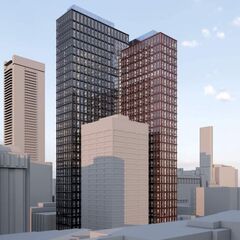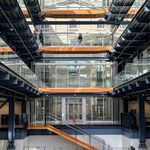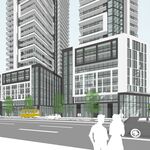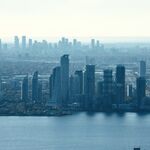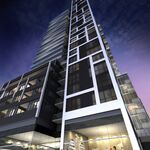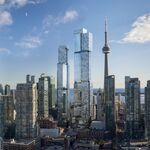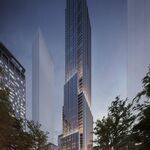A couple blocks northwest of City Hall in Downtown Toronto, Crown Realty Partners has submitted Official Plan, Zoning By-law Amendment, and Site Plan Approval applications to the City for two 72-storey towers connected by a four-storey base building with mostly residential use at 123 Edward Street.
 View looking southeast towards proposed development, image from submission to the City
View looking southeast towards proposed development, image from submission to the City
The site covers most of a city block, which currently has two office buildings and a parking structure on it. The parking structure in the southwest corner and the office building along the north side would be demolished and replaced with the proposed development. The 25-storey/105 metre-tall commercial office building that is located at the southeast corner of the site fronting onto Dundas Street and Chestnut Street would be retained, with the proposed buildings wrapping around it.
 Location of proposed site, image from submission to the City
Location of proposed site, image from submission to the City
 Office building that is proposed to be demolished, image retrieved from Google Street View
Office building that is proposed to be demolished, image retrieved from Google Street View
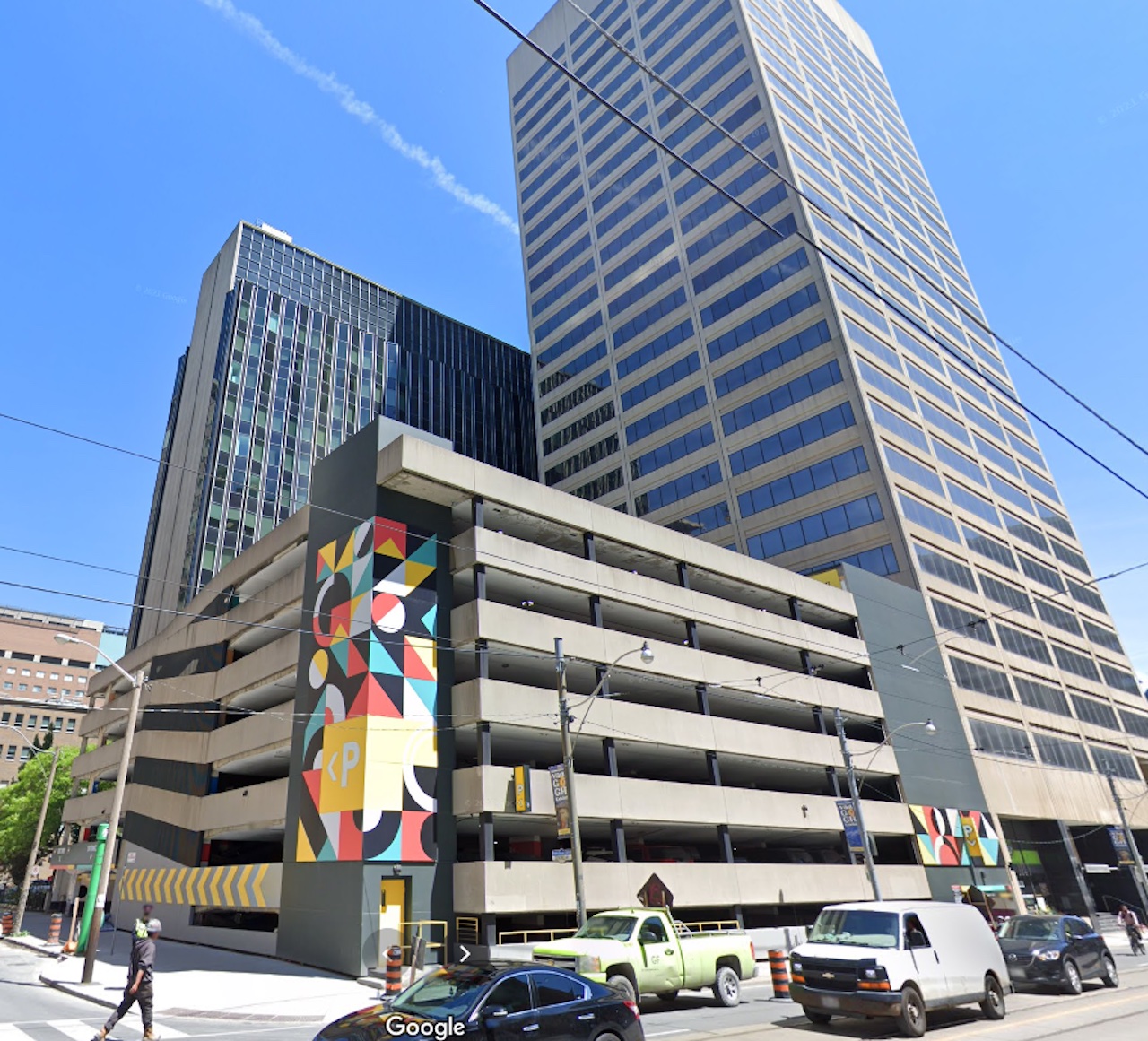 Parking structure that is proposed to be demolished, image retrieved from Google Street View
Parking structure that is proposed to be demolished, image retrieved from Google Street View
Designed by Turner Fleischer Architects, the proposed buildings would have a combined Gross Floor Area (GFA) of 124,852m² and a Floor Space Index (FSI) of 40.6 on the site. The proposed tower floor-plates are larger than the 750m² floor-plates that the City typically wants in residential towers, at approximately 830m² and 1,040m². The City recommends the smaller floor-plate so as to reduce the amount of shadow cast on the surrounding area.
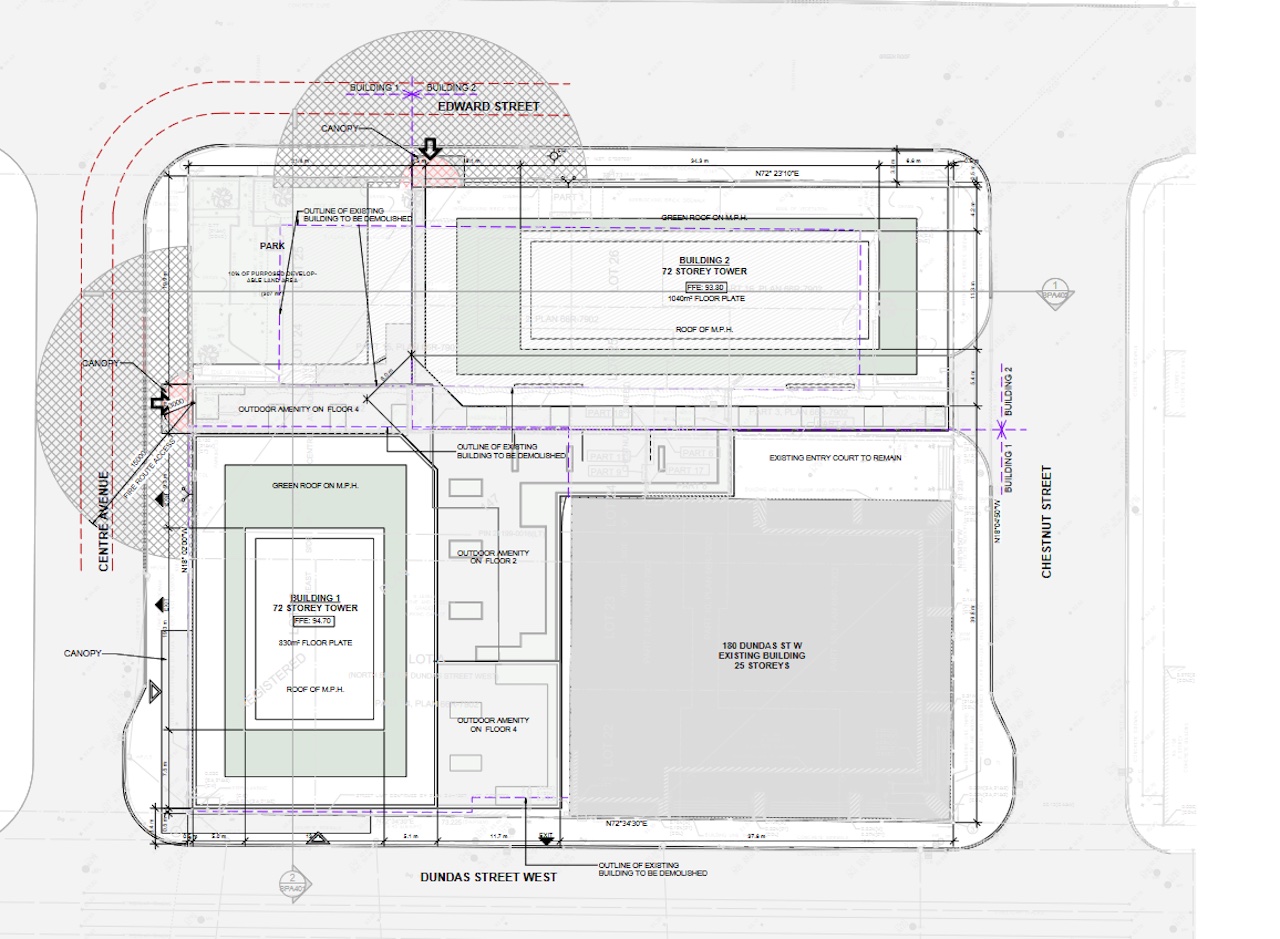 Site plan of proposed development showing proximity of proposed towers, image from submission to the City
Site plan of proposed development showing proximity of proposed towers, image from submission to the City
The towers, at their close corners, would be separated from each other by just 6 metres – a tight squeeze by the City's standards, which asks for a minimum of 25 metres between buildings. The separation distances between the new towers and the existing office tower is also far less than the City looks for, as the west tower would be just 11.7 metres away, while the north tower would be positioned even closer, at about 8 metres. The City considers separation distance important, so that both adequate light reaches suites and the residents are provided with some privacy. Based on the difference in height between office floors and residential floors, residents on the east side of the west tower and south side of the north tower as high as the 33rd floor would face those far-less-than-standard separation distances to a nearby building. Residents on the 34th storey and above would clear the height of the existing adjacent office tower.
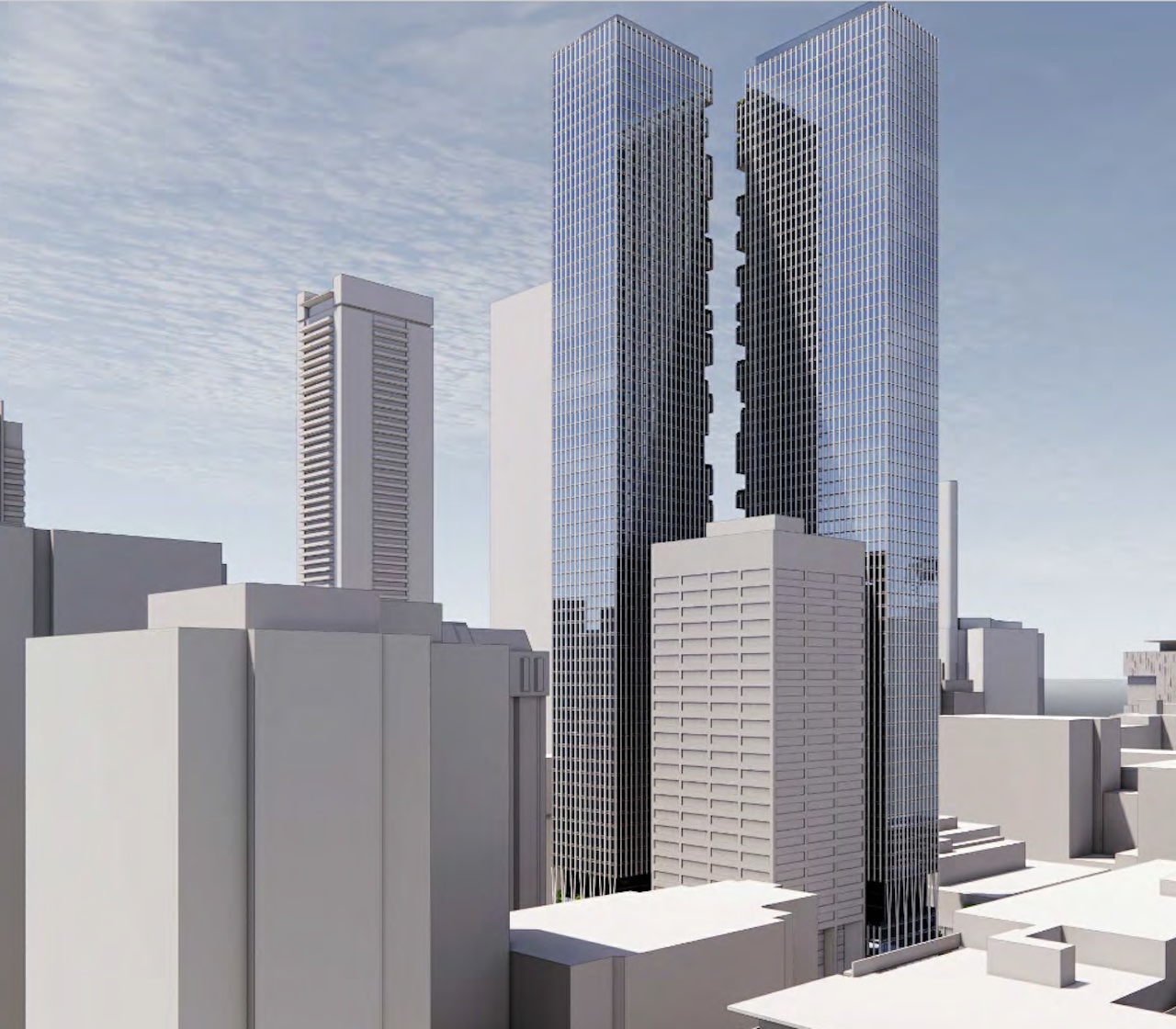 View looking northwest towards proposed development, image from submission to the City
View looking northwest towards proposed development, image from submission to the City
A total of 1,889 residential units are proposed between the two buildings, broken down into 89 studios (5%), 1116 one-bedrooms (59%), 486 two-bedrooms (26%), and 198 three-bedrooms (10%).
The first tower would contain 779 of those units, while the second tower would contain 1,110. Both towers would have three elevators servicing them, offering a one elevator to 260-unit ratio for the first tower, and a one elevator to 370-unit ratio for the second tower.
While there are no standards in Ontario requiring a particular number of elevators per unit, a generally accepted target for elevator to unit ratio is one elevator for each 100 units in a high rise tower (although this article recommends one elevator per 90 residential units). While other recent proposals have been increasing the number of units per elevator, such as at 145 Wellington West which we recently wrote about that proposes 4 elevators for its 512 suites, or one elevator to 128 units, we have never seen anything close to one elevator per 260 units, let alone one per 370.
The proposed development provides 1,938m² of indoor amenity space and 1,181m² of outdoor amenity space. Indoor amenity space is proposed within the shared base building on part of floors two to four. The fourth floor outdoor amenity space would wrap around the two towers, as well as internally, encompassing the entirety of the base building space providing a continuous connection between indoor and outdoor amenity areas.
At grade, a 307m² park designed by The Planning Partnership is proposed at the northwest corner of the site to satisfy the City's parkland dedication requirements of 10% of the land. Seating and canopy trees are proposed to be provided along the east side of the park, adjacent to the north tower fronting Edward Street.
 Looking southeast from Edward and Centre streets, image from submission to the City
Looking southeast from Edward and Centre streets, image from submission to the City
The primary pedestrian entrance for the proposed development would be located internally from Centre Avenue for the west building, and from Edward Street for the north building, with both entrances facing the public park. Retail space of 223m² is proposed at grade which would have entrances provided from Centre Avenue and Dundas Street West for the ground floor retail of the first building. The north building, where there is currently retail facing the sidewalk, would only have residential lobby space facing the street for the west half of the frontage, while the east half would be a solid wall with garbage handling facilities hidden behind it.
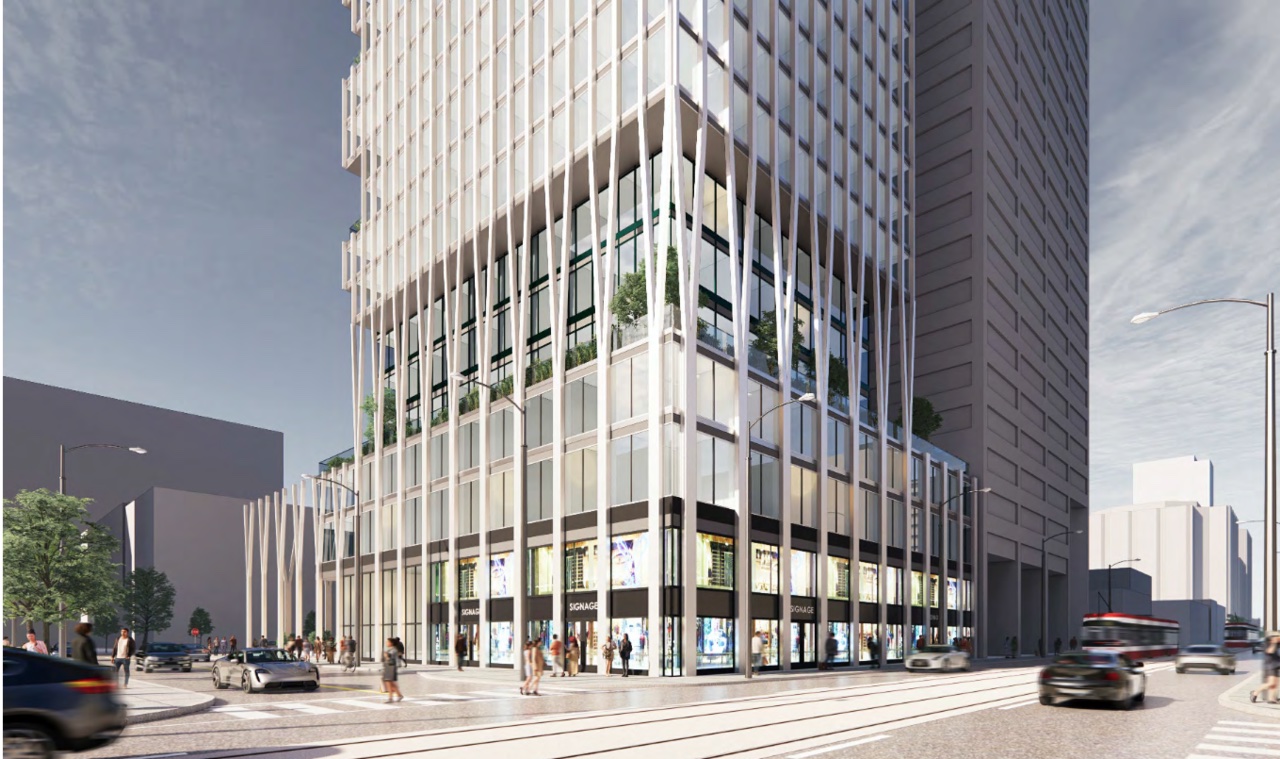 Proposed retail units at base of first building, image from submission to the City
Proposed retail units at base of first building, image from submission to the City
Just a one-to-two-minute walk from St Patrick subway station, and served by the 504 Dundas streetcars, a total of only 48 parking spaces for visitor and commercial parking are proposed in the development in one level of underground parking, of which 10 spaces would be for electric vehicle charging. No residential parking is proposed.
The proposed development would also offer a total of 1,891 resident bicycle parking spaces on the mezzanine and second storey of the base building, which would include 1,701 long term spaces and 190 short term spaces. Electric bike charging would be provided in 285 spaces.
UrbanToronto will continue to follow updates for this ;proposal, but in the meantime, you can learn more from our Database file for the project, linked below. If you'd like, you can join in on the conversation in the associated Project Forum thread, or leave a comment in the space provided on this page.
* * *
UrbanToronto’s new data research service, UrbanToronto Pro, offers comprehensive information on construction projects in the Greater Toronto Area—from proposal right through to completion stages. In addition, our subscription newsletter, New Development Insider, drops in your mailbox daily to help you track projects through the planning process.
| Related Companies: | Arcadis, Crozier Consulting Engineers, Grounded Engineering Inc., HGC Noise Vibration Acoustics, Sysconverge Inc, Turner Fleischer Architects |

 16K
16K 



